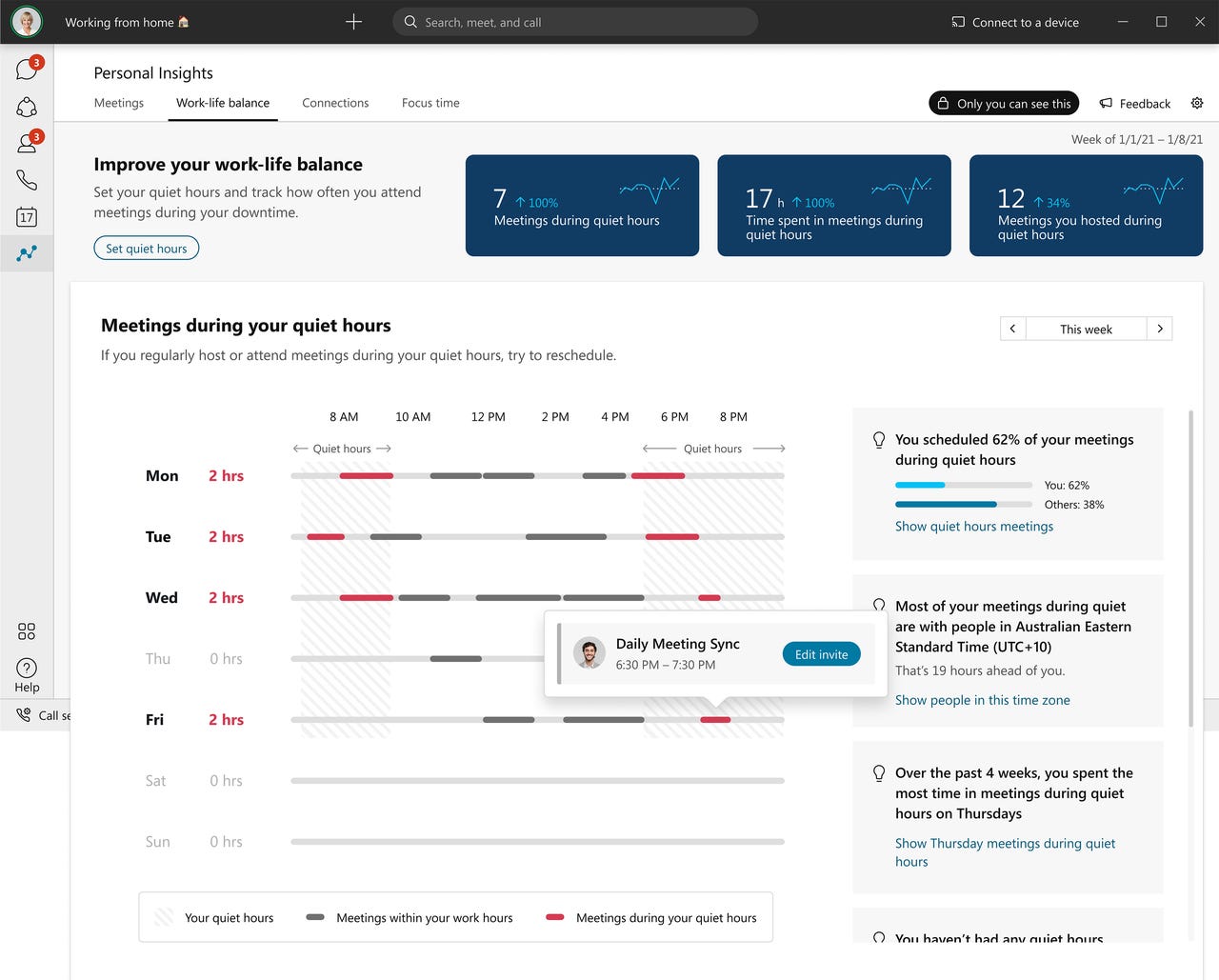Cisco adds new "People Insights" to Webex for a work-focused spin on digital wellness


As digital life becomes more prevalent, it can be easy to slip into bad habits, like doomscrolling or interrupting family time with screen time. The same is true for one's work life -- meetings slide past traditional work hours, and team engagement can be trickier to manage.
Consumer tech giants have responded to this problem with tools to help you manage your personal screen time. Now Cisco is adding new "People Insights" to Webex to help you keep your professional screen time on track.
The new feature gives Cisco users stats on the way they use the videoconferencing tool. It can help them meet certain goals, such as ensuring meetings are held during office hours. It can also surface trends they may not have noticed otherwise, such as if they're consistently tuning into meetings late. It can tell you about your tendency to multi-task during meetings, or it can tell you who you collaborate the most with.
Critically, Cisco says the new feature was built to ensure privacy -- so that one user's personal insights don't fall into the hands of a manager.
"People Insights is not designed so we can go out and create a culture of inspection -- that's not the goal," Jeetu Patel, Cisco's SVP and GM Security and Collaboration, said to ZDNet.
Furthermore, he said, People Insights isn't primarily a "productivity" tool.
"Yes, we want to give people an idea of productivity," he said. "More importantly, we want to give them an idea of how they're doing from a well-being standpoint, and how they're nurturing relationships."
Cisco is rolling out People Insights to select Webex users this summer. It should be available globally at no additional charge within the next year.
While Cisco is stressing that privacy was a priority in its design, the company is also offering People Insights for teams and for organizations. Team Insights give each team member a view of patterns between connections, collaboration habits, and work-life integration for the entire team. Organizational Insights provide a bird's-eye view of your organization's collaboration trends and patterns.
Patel said there are guardrails to prevent it from becoming a tool for employee surveillance. For instance, data is anonymized and aggregated, so a manager can learn whether his sales and marketing teams are communicating enough -- but he can't learn how often one specific salesperson is communicating with others. In some cases, individuals have to opt into being included, and in other cases they can opt out.
There are tools that enable managers to monitor remote workers, but Patel said that use case is not at all a priority for Cisco.
"It's not hard to build those capabilities, we just don't," he said. "We're going to choose not to do those because that's not part of [Cisco's] core values."
Patel said the new features are part of Cisco's aim to tailor Webex for a post-pandemic work world that permanently blends in-office work with remote work. The sudden shift to remote work has taken a toll on workers, but the next shift may be even harder, Patel said.
"I think the world's going to change yet again one more time, as people move into this hybrid world," Patel said. "Companies have a responsibility to make sure they're not just optimized for productivity... There should be some degree of balance in life."
Ultimately, he said, supporting work-life balance is a sound business decision. "In the long term, sustained productivity is a byproduct of employee well being."
Cisco on Wednesday also previewed a future Webex capability called "People Focus." Using AI deployed via Cisco hardware, the feature re-frames Webex meeting participants who are in the same meeting room. With this feature, a remote participant would see cropped, close-up images of each participant, rather than one image of everyone else sitting together. The idea is to put the remote participant on equal footing with the other people in the meeting, giving that person the opportunity to read people's facial expressions and body language. The feature will be available later this year.
Prior and related coverage:
- WFH has left workers feeling abandoned. So they're making their own plans for the future instead
- Your quantified self on steroids: Amazon's Halo and Halo Band are creepy and kinda cool
- More bosses are using software to monitor remote workers. Not everyone is happy about it
- Finding remote work a struggle? Here's how to get your team back on track